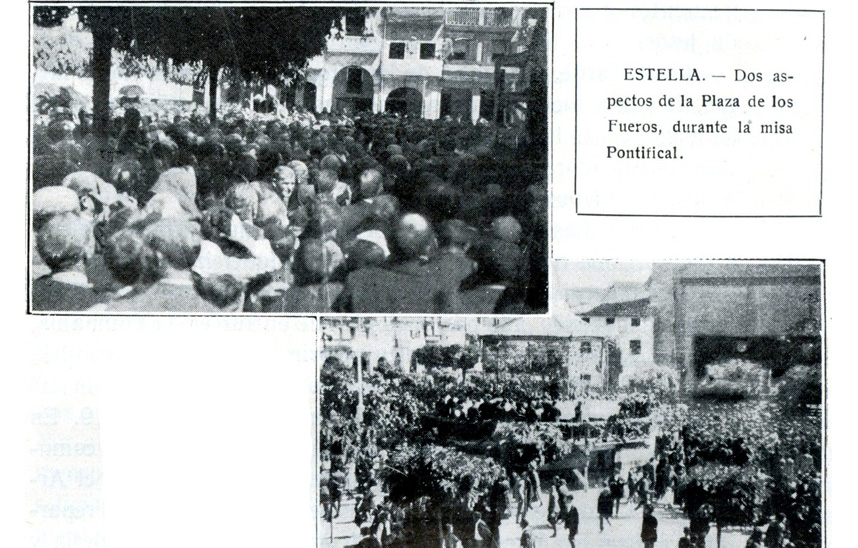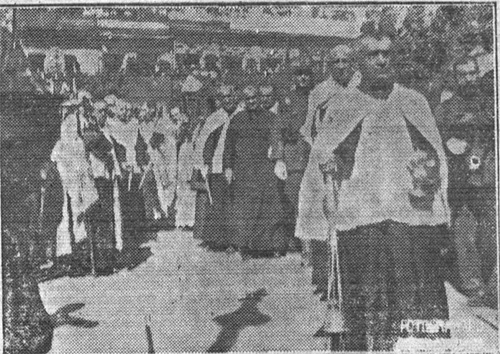Images in Navarra of the III Centenary of the canonization of Xavier (III)

FotoFotosde la Crónica del Centenario/ A couple of snapshots of the visit of the relics to Estella.
The organizers of the celebration of those anniversaries in 1922 made sure that the relic of the Navarrese saint, which arrived from Rome, visited different localities in order to make as many Navarrese people as possible participate in the spirit of the celebration. For this purpose, agreement was sought between the Organizing Commission and the Jesuits, reserving the care of the relic to Father Antonio Astrain, author of the voluminous History of the Society of Jesus in the attendance of Spain. At the beginning, it was thought that there would be very few stops and visits, something that was later rethought, making more in order to satisfy the requests of different localities. On the three days there were sermons and morning and afternoon functions, as well as general communion masses for men and women announced by Father Eustaquio Miqueleiz, former parish priest of San Miguel de Estella, before joining the Society of Jesus in 1895, who stood out as a great sacred orator and missionary in France and Spain.
In Estella
The Bishop of Jaca arrived in the city of Ega with Fathers Astrain and Nagore in a car of the Provincial Council. He also took the Christ of the Crab. Half a hundred towns were waiting there. In Enériz and Puente la Reina there was a blessing and a very brief stop. The relic was in Estella for three days, September 17, 18 and 19. On September 17, the Archbishop of Seville was waiting at the Town Hall to receive the relic and place it on an altar in the vestibule. The procession left for place accompanied by the Piarists of Irache, the Capuchins and forty priests. The Mass took place in the open air on an altar erected in front of the façade of the parish of San Juan. The stage set up for the authorities and the clergy measured two hundred square meters. In the afternoon, the relic was venerated for five hours, from 1:00 p.m. to 7:00 p.m. average and 5,200 people were counted.
The report of Father Constancio Eguía states that Estella with its surroundings "was the first to be moved... by the work of the same holy Arm were put in motion, as an immense army at his orders, a hundred or more priests, several religious of one and the other sex ....More than fifteen hundred soldiers of the battalion of the military orders that covered the degree program and gave him escort for three days with his flag and music (which in Estella had the saint the honors of captain general with command in place). And a crowded and fervent crowd.... There in the sky sounded the mortar shots, as discharges of arquebuses and muskets, or as batteries of those that so often besieged the valley from that frontier castle..... The towers of its monumental churches spoke through the language of its bells, that when they rang, they seemed to jump from their hinges. A multiplied rocketry multiplied booms and lights. In the bandstand of the music, widened for this case, sang a monumental choir in which the three organists of the population entered with all its elements, and only of Irache up to sixty young singers. Further down, in the plain, the band of the regiment of Órdenes was extended, playing with the orchestra, the harmoniums and the choral mass, or executing their own programs on a par with the municipal band".

Procession through the streets of Estella. Photo published by Diario de Navarra, September 20, 1922.
The extensive chronicle of Diario de Navarra provides important details. issue It begins by pointing out that it would be difficult to trace in memory an event like that of the 17th, due to the high number of people who arrived, from early in the morning in buses and private buses, trucks, cars, galleys and all means of transport subject . By nine o'clock in the morning the processional degree program from the Town Hall to the place and the latter were fully packed, with the balconies of the route full of people. The reception took place at the portal of St. Augustine from where they went to the Town Hall. In front of the house, where according to tradition the saint lived, a choir of more than five hundred voices sang "the popular hymn composed and directed by Maestro Hugarte", undoubtedly the organist of the parish of San Pedro and later of San Juan, Alfonso Ugarte Leturia. This same maestro conducted a choir of 120 voices, which interpreted the mass of Vicente Goicoechea, accompanied by a pair of harmoniums and orchestra. After the mass, Wranken's Te Deum was intoned, conducted by the aforementioned Ugarte, to conclude with the Hymn to the saint in four voices by the latter organist from Estella.
The same newspaper provides the menu of the banquet, served by the Hotel Comercio, which consisted of hors d'oeuvres, consommé Royal, fried food, partridges with mushrooms, lobster, ham in jam, rum punch, roasted chickens, desserts, champagne, coffee and cigars. During the meal, the municipal band gave a concert.
In the newspaper El Pensamiento Navarro, it was concluded after narrating the crowds of people, the overflowing joy and the functions already described that those conference had been very memorable for the annals of the city.
LEARN MORE
Diario de Navarra, September 19, 1922, p. 1.
EGUÍA RUIZ, C., Reliquias de San Ignacio de Loyola y San Francisco Javier. Su recorrido triunfal por España, Madrid, Blass, S. A. Tipográfica, 1924.
El Pensamiento Navarro, September 19, 1922.
